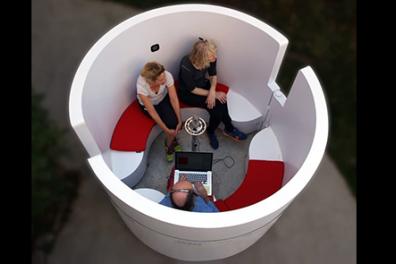The conversational capsule

Malagasy, a language like any other...
Malagasy began to be taught at Inalco in 1898. And to this day, our institute remains the only university in the world to offer teaching of Malagasy as a foreign language as part of a university curriculum (bachelor - master - doctorate).
Among the hundred or so languages taught at Inalco, Malagasy is one of the so-called "small languages", i.e. languages with a low student enrolment and limited geopolitical influence.
.
Even if the fact of being a small-scale language necessarily generates specificities in terms of course organization and content, the fact remains that students of Malagasy share the same needs as those of the "big" vernacular languages.
These include contact and familiarization with an "everyday" language (Blanche-Benveniste: 304)[1]. However, documentation and description of this everyday language are regularly lacking, both for languages with small numbers of learners and for those with large numbers of learners.
This situation is the result of a number of factors, such as the collection of authentic oral data, the use of such data when it has been collected, and the processing of such data: how to didactize it? what to do with the variation it illustrates? what terminology, what metalanguage to use, etc.
.
Thus, in their classes, students often have to deal with a language constructed by the describer, the grammarian or the theorist, and the teacher is faced with the paradoxical situation of having at his or her disposal mostly - if not only - resources on oral language illustrating a minority usage of native speakers, what Blanche-Benveniste (Ibid.) calls "the Sunday language". For it is this standardized language that most often appears in the books available for the language classroom, the "language of everyday life" being excluded.
.
The conversational capsule
It was against this backdrop that a project[2] was born, with the aim of collecting oral corpora at Inalco, and taking as its basis the use of the "conversational capsule". Designed to meet the oral and spontaneous language data needs of linguists, teachers and designers of connected objects, for example, this innovative device combines art, technology and digital technology. It is the result of a collaboration between linguists, a painter specializing in digital arts, GuyKayser, and a computer scientist, Gérard Parésys. Produced as part of the "Les voix dans l'escalier" project, this nomadic interactive work is designed to enable the collection of oral corpora.
The conversational capsule takes the form of a closed space (it can also adopt an open position, but this is less favorable to the collection of voices free from interfering sounds), comfortable and welcoming, in which the speakers, volunteering to be recorded, sit down, over a coffee for example. The capsule's technical equipment enables the speakers' speech to be digitally recorded, and the resulting corpus to be digitally preprocessed.
By entering the capsule to be recorded, speakers become directly involved in the production of the data base and in the constitution of a heritage. Generally speaking, the captation can be more or less directed by the collector, and thus give rise, for example, to the collection of discussions, interviews, readings aloud, literary speech such as declamations, oratorical jousts, etc.
The perspectives are numerous.
The prospects are numerous.
The contribution of collected corpora
In this way, the conversational capsule can potentially be of interest to most of the 100 languages taught at Inalco, in different ways: "large" vernacular languages and their uses or evolutions; "small" languages for understanding distant civilizations, documenting communication and interaction with their speakers.
From a universal base, shared by all languages, and which relates to the need for authentic resources to ensure teaching that takes into account as closely as possible the realities of the language as it is "really spoken" by its speakers, the teacher will be able to choose the object of the heritage that he or she is going to build up.
This total freedom in terms of form - free or semi-directed, several speakers or just one - and content - everyday or literary language; conversations or monologues; an imposed or totally free theme - means that the collector can design his or her recording for teaching, research, heritage or documentation purposes.
Depending on the case, the corpus can be used for a wide range of purposes, including: teaching, research, heritage or documentation.
Depending on the case, the corpus may be used directly as a support in the language class, but it may also serve other purposes: for example, to create dictionaries, lexicons or guides (for future expatriates, for example), to preserve a regional usage, a contemporary or literary language, or a state of language intrinsically destined to evolve. The collection may also focus on a very specific theme for which resources are scarce or non-existent.
Finally, while documenting the use of the language by its speakers, the capsule can also enrich disciplinary knowledge of a particular cultural area (linguistic, anthropological, literary, etc.) and provide resources that can be exploited in the context of multilingual and multicultural training and communication.
Note: the conversational capsule will be installed at Inalco from November 12 to mid-December 2020. During these weeks, everyone will be able to use it to build up corpora that meet their needs.
Louise Ouvrard
Head of the Malagasy studies section.
Director of the C.F.I. "Communication et Formation Interculturelles"
program.
Find out more
http://gerard.paresys.free.fr/Journal/Capsule.html
[1] Blanche-Benveniste, Claire, 2013, "La langue du dimanche et la langue de tous les jours", Revue Tranel, vol. 58, pp. 301-305.
[2] Funding DGLFLF (délégation générale à la langue française et aux langues de France attached to the Ministry of Culture) - 2019.